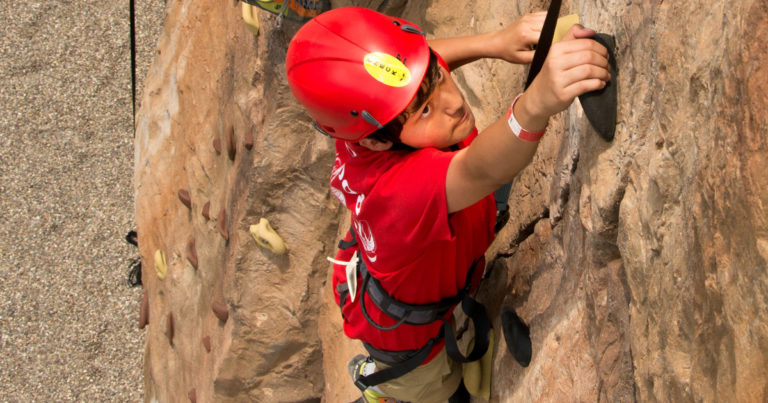Why are Scouts and Venturers required to wear helmets when rock climbing?

Proper gear for climbing includes a quality harness, good rope, the right clothing and shoes — and a climbing helmet.
I was surprised to learn the reason we wear helmets when rock climbing goes beyond merely cushioning the cranium in a fall.
Climbing helmets also shield your skull from falling objects like rocks or gear … or the cellphone of someone climbing a parallel route.
If you slip when climbing, your belayer keeps you from falling down. But it’s your helmet that protects your head if your momentum sends you flying back into the climbing surface.
Here’s what else you should know about climbing helmets.

Who must wear a helmet during rock climbing/rappelling?
Every participant in the fall zone of any BSA climbing or rappelling activity must wear a helmet that is designed for ropes courses or climbing.
That means the person on the wall, the belayer and anyone walking around in the climbing area.
How do you pick the right climbing helmet?
Climbing helmets have suspension systems made of either webbing or foam. Other kinds of helmets such as those intended for bicyclists, skaters, construction workers, or football players are not specifically designed for climbing and are not acceptable.
When selecting helmets, consider ventilation, ease of adjustability, and color (dark colors absorb heat; light colors reflect it).
It’s a good idea for climbing instructors to wear helmets of a distinctive color. This makes them easier to identify in a group.
How do you ensure proper helmet fit?
Adults should help make sure that every participant’s helmet is adjusted to fit properly. Never allow a helmet to be worn tipped back to expose the forehead.
Participants may complain at times that helmets feel hot or uncomfortable, but the assurance of increased safety far outweighs any minor discomfort.
When is a helmet no longer fit to wear?
All climbing helmets must be retired according to the manufacturer’s recommendations — or sooner if one shows signs of wear or sustains significant impact.
Follow any additional manufacturer’s guidelines for retiring helmets.

What if your pack, troop or crew is climbing at a commercial climbing facility where helmets aren’t required?
Which takes precedence: the BSA’s requirements or those of the climbing gym?
You’ll find the relevant reference in Climb On Safely, a document that outlines the BSA’s climbing program. Look in Section 5: Equipment.
I’ve added bold for emphasis.
The climbing instructor should verify that the proper equipment is available for the size and ability level of the participants. Helmets, harnesses, rope, and climbing hardware must meet appropriate requirements as outlined in Belay On. All equipment must be acquired new and/or furnished by the instructor and retired according to the manufacturer’s recommendations.
When using a climbing gym, the climbing facility’s procedures apply.
In other words: If the gym does not require helmets, then the Scouts are not required to use them.
All of that said, a good Scout leader should carefully evaluate the conditions for any Scout activity. If the leader determines that using helmets may enhance the safety of his or her Scouts or Venturers, then the leader might discuss this with the facility managers and bring their own helmets or choose to do the climbing activity elsewhere.
Where can you find BSA climbing resources?
Climb on Safely: The BSA’s procedure for organizing BSA climbing/rappelling activities at a natural site or a specifically designed facility such as a climbing wall or tower.
Belay On: Reference manual used as a resource for COPE and climbing programs operated within the Boy Scouts of America.
Thanks to these top volunteers on the BSA’s COPE and Climbing National Task Force for the help: Chris Moon, John Winter and Rhonda Wright.
Why are Scouts and Venturers required to wear helmets when rock climbing?
